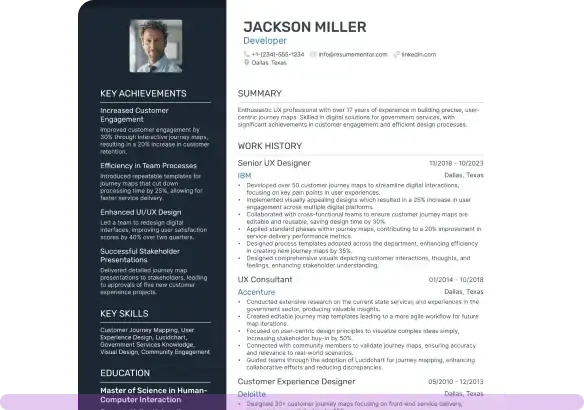Problem Manager Resume Examples

Jul 18, 2024
|
12 min read
Crafting the perfect problem manager resume: solving puzzles of professional perfection, one skill at a time. Learn how to highlight your experience and skills to stand out in the job market.
Rated by 348 people
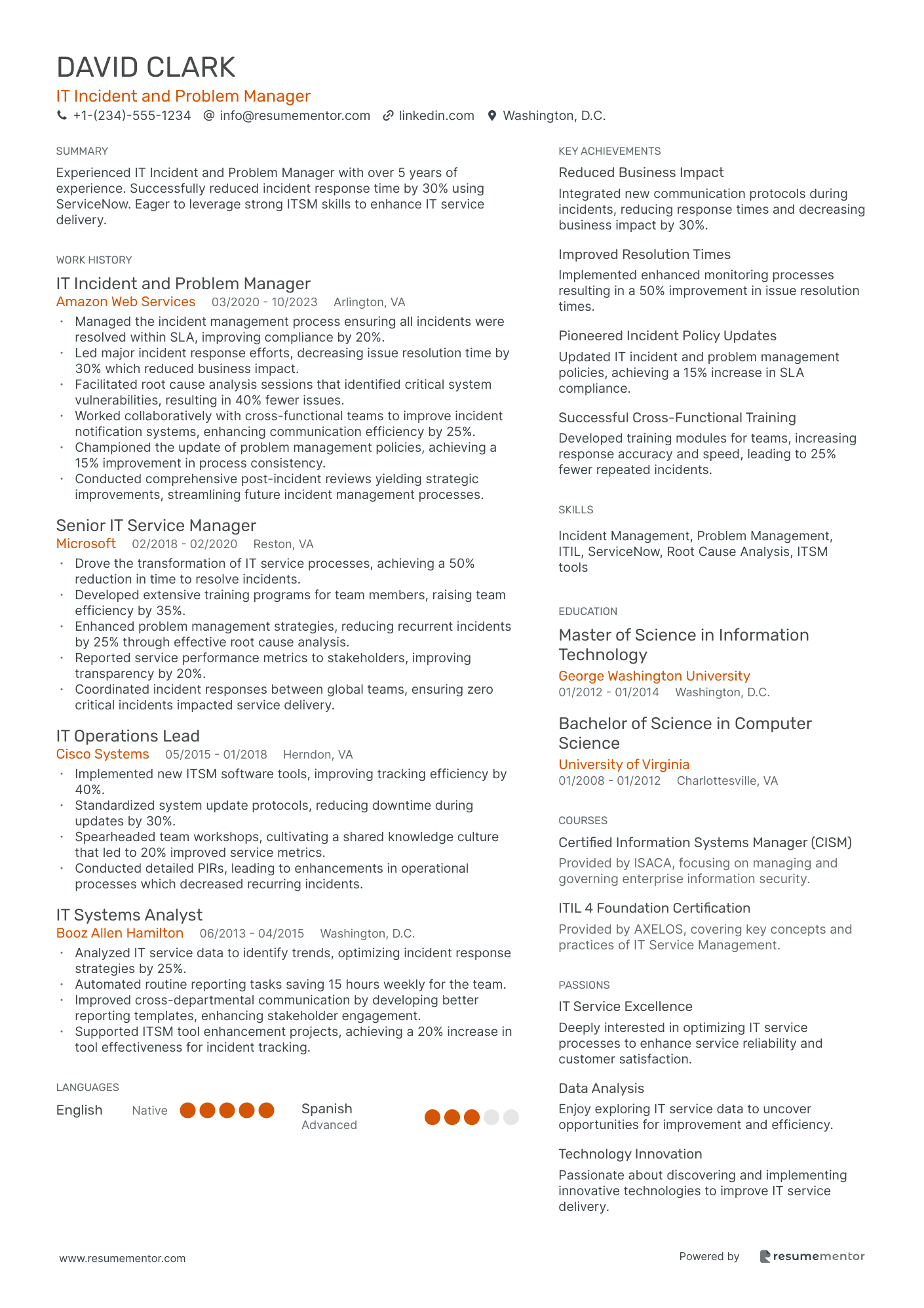
IT Incident and Problem Manager
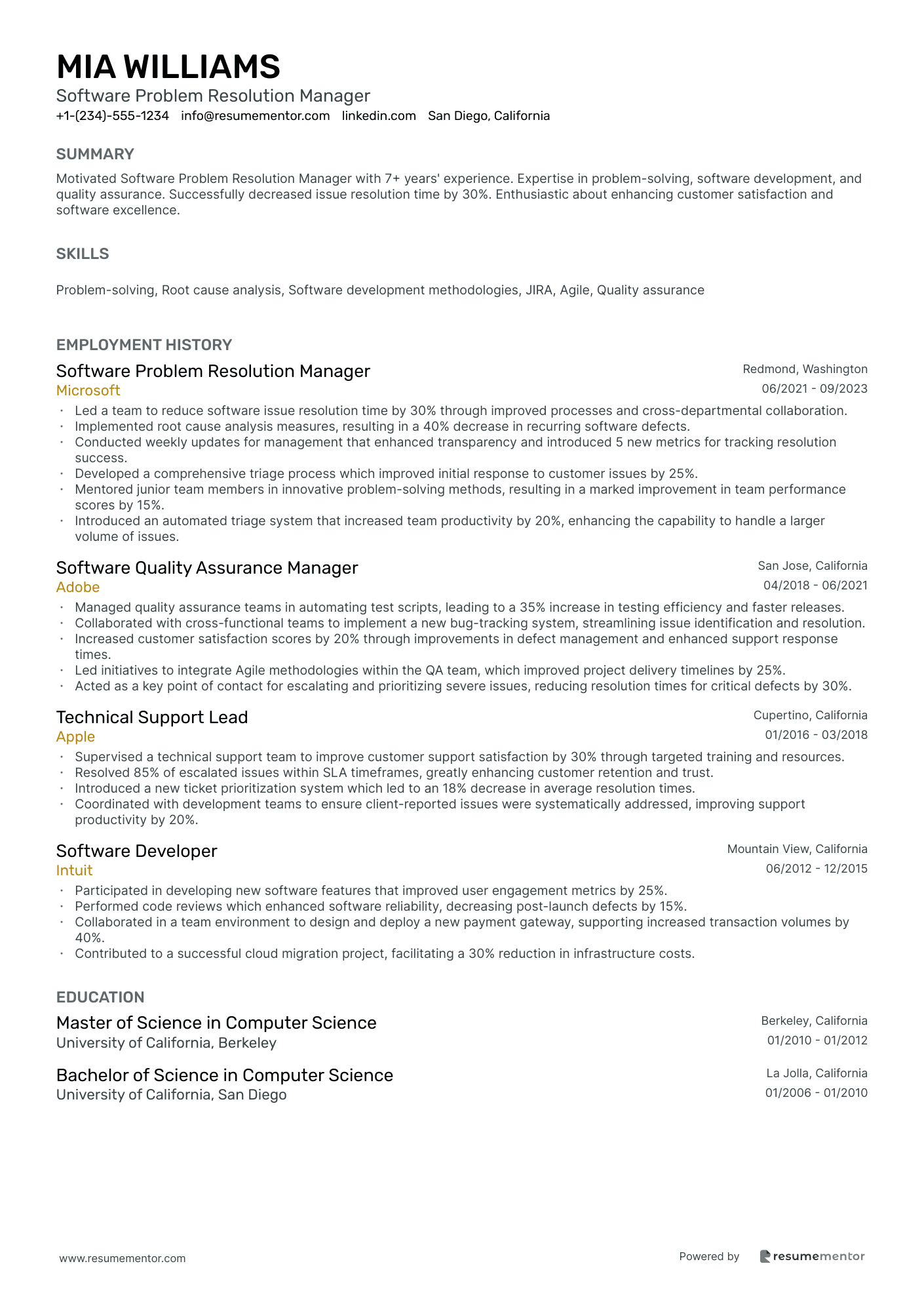
Software Problem Resolution Manager
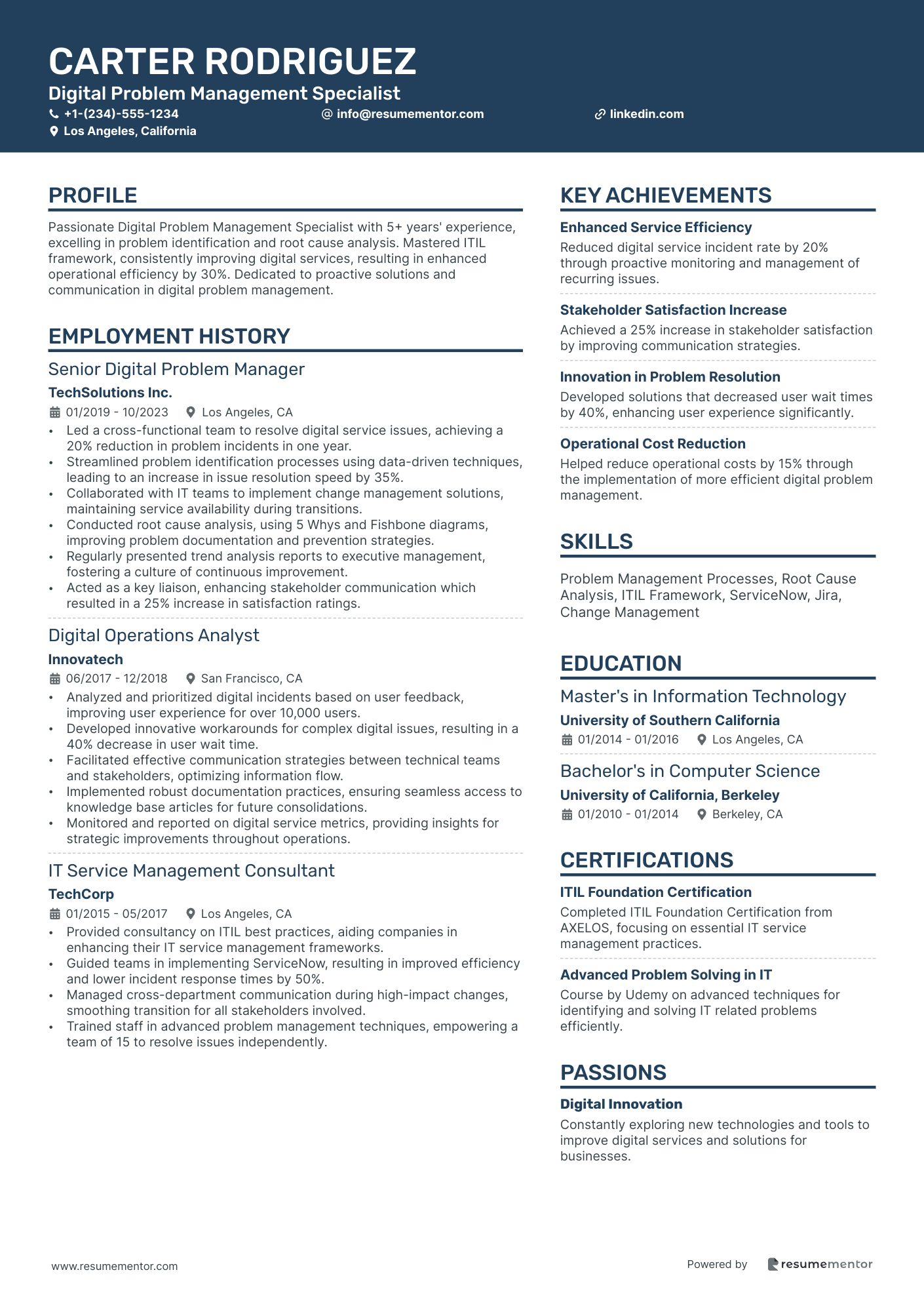
Digital Problem Management Specialist
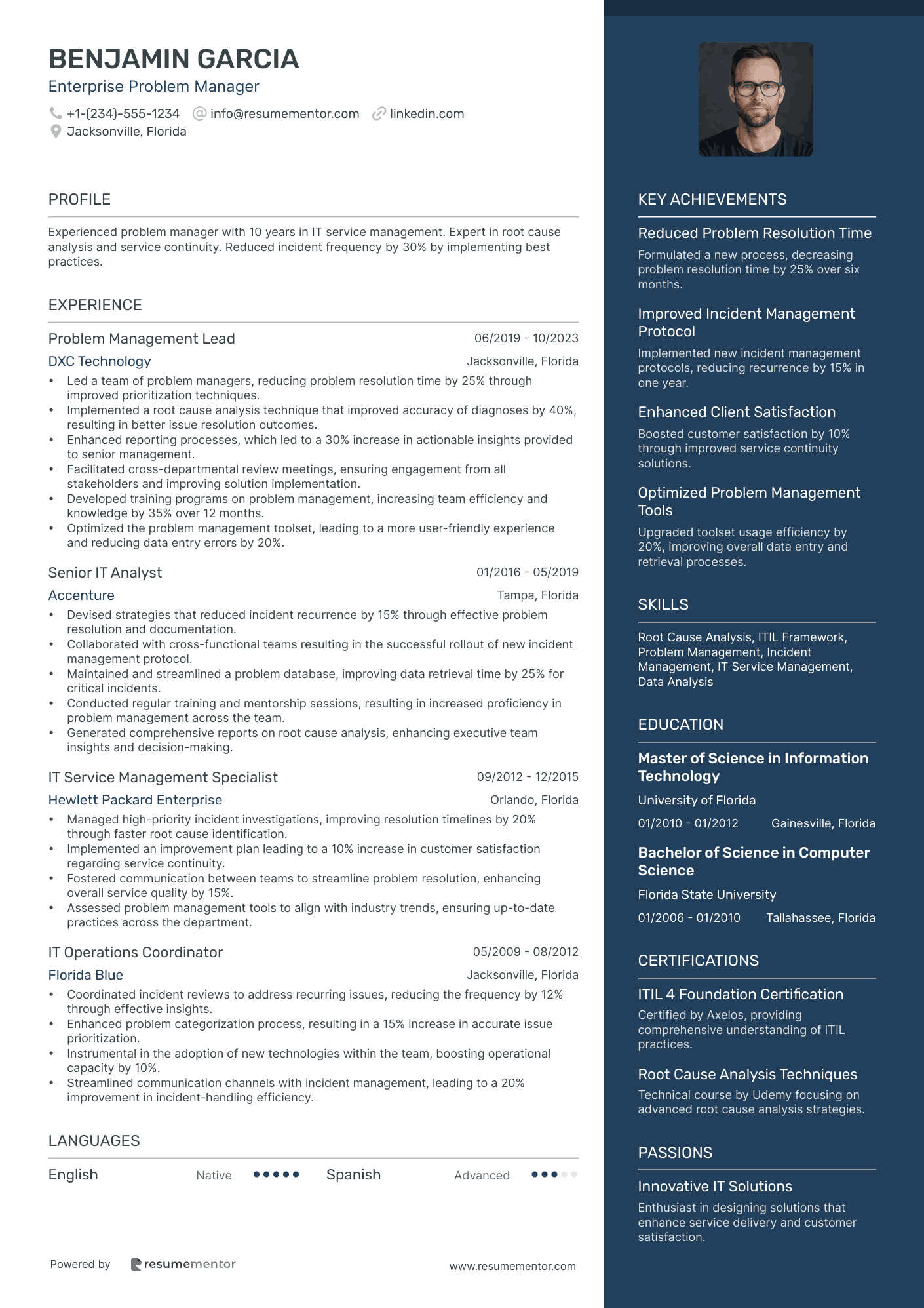
Enterprise Problem Manager
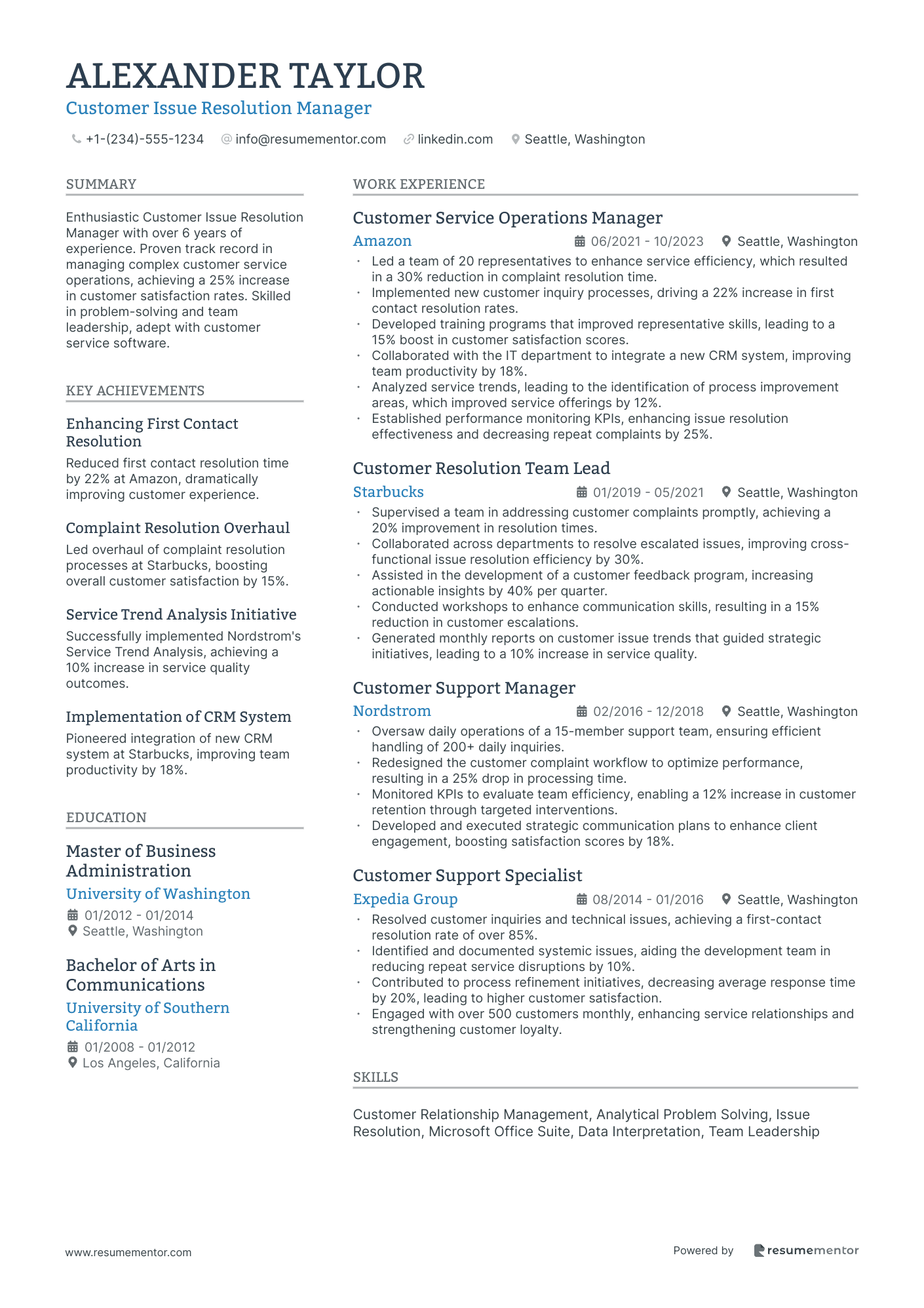
Customer Issue Resolution Manager
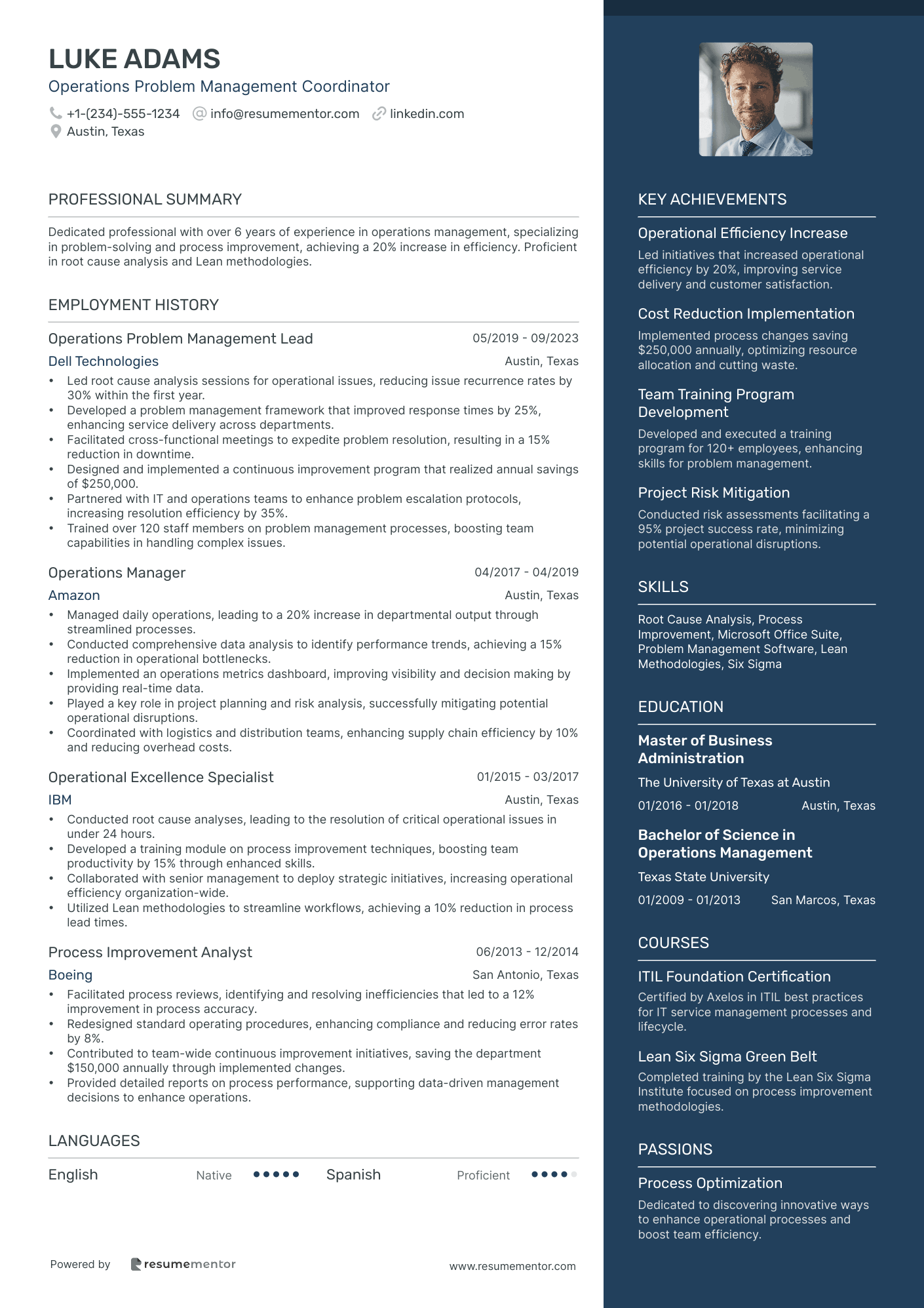
Operations Problem Management Coordinator
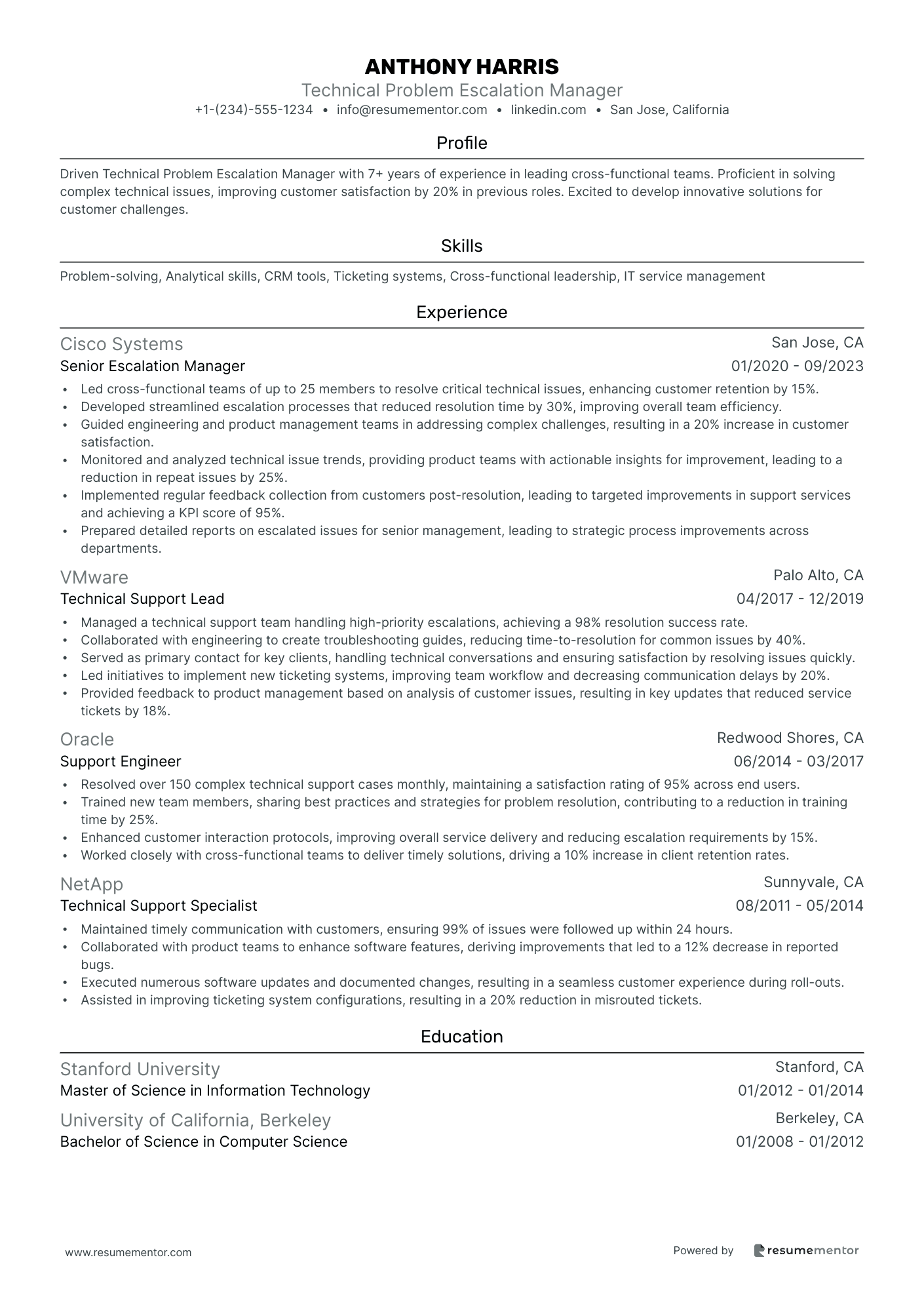
Technical Problem Escalation Manager
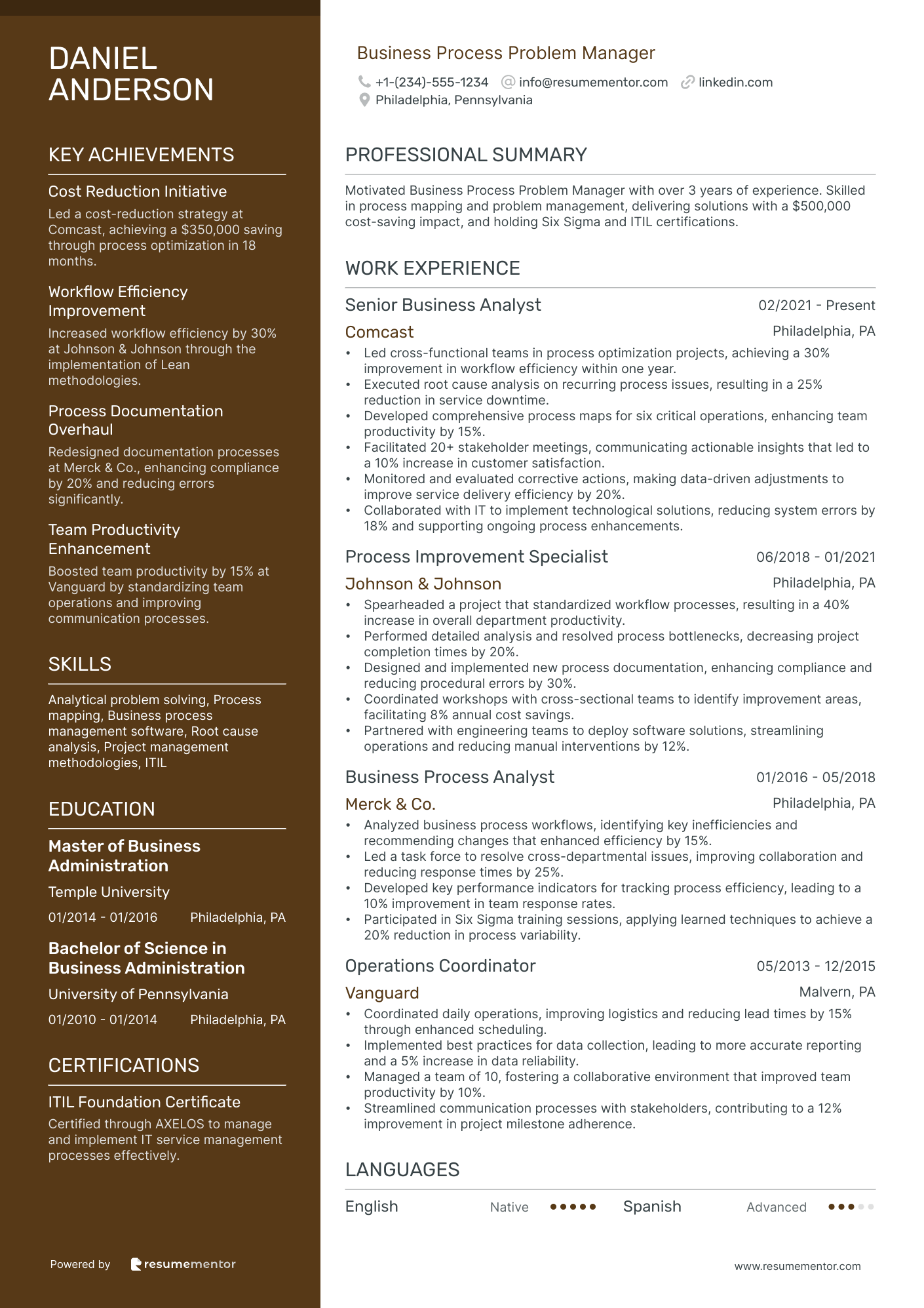
Business Process Problem Manager
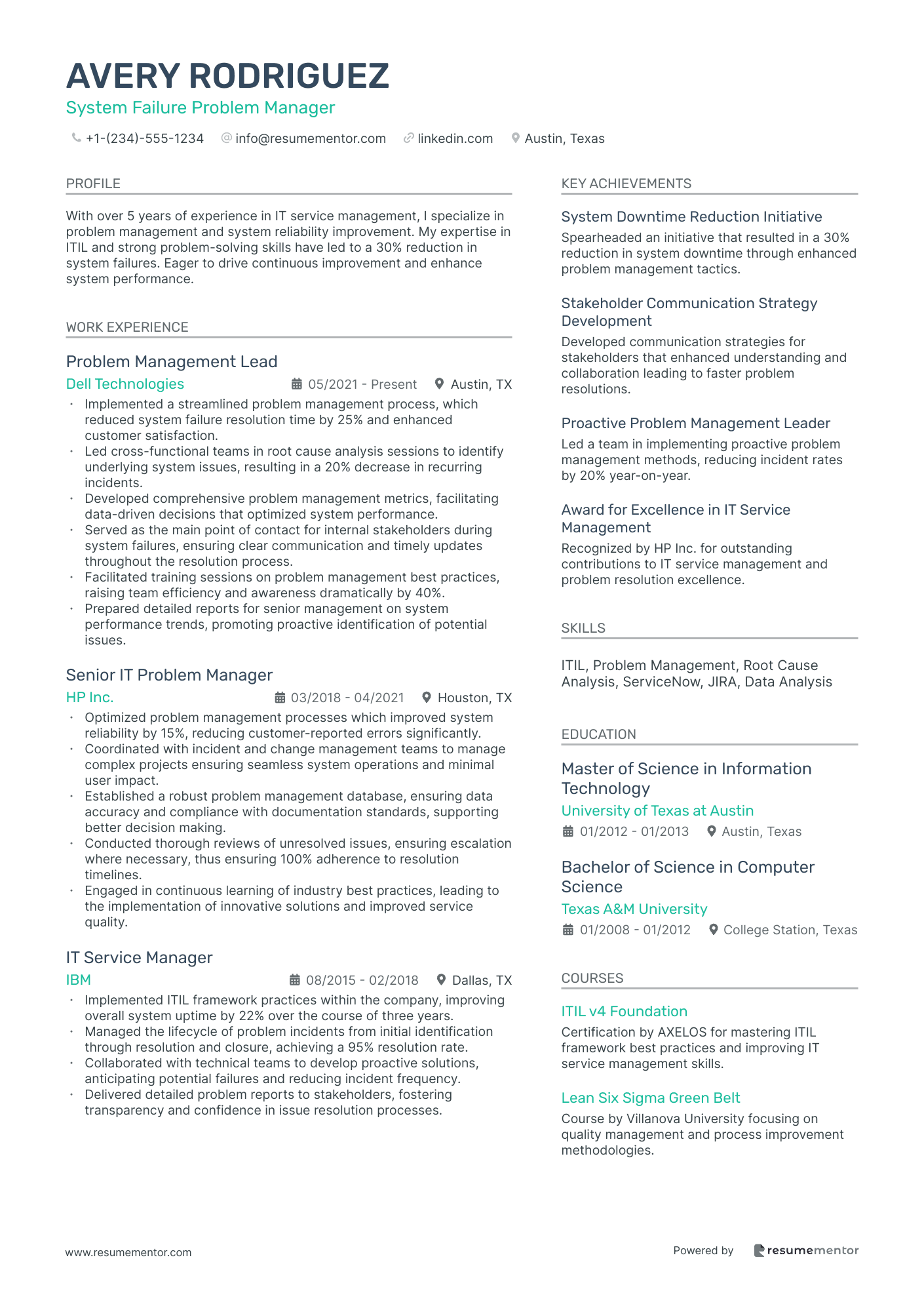
System Failure Problem Manager
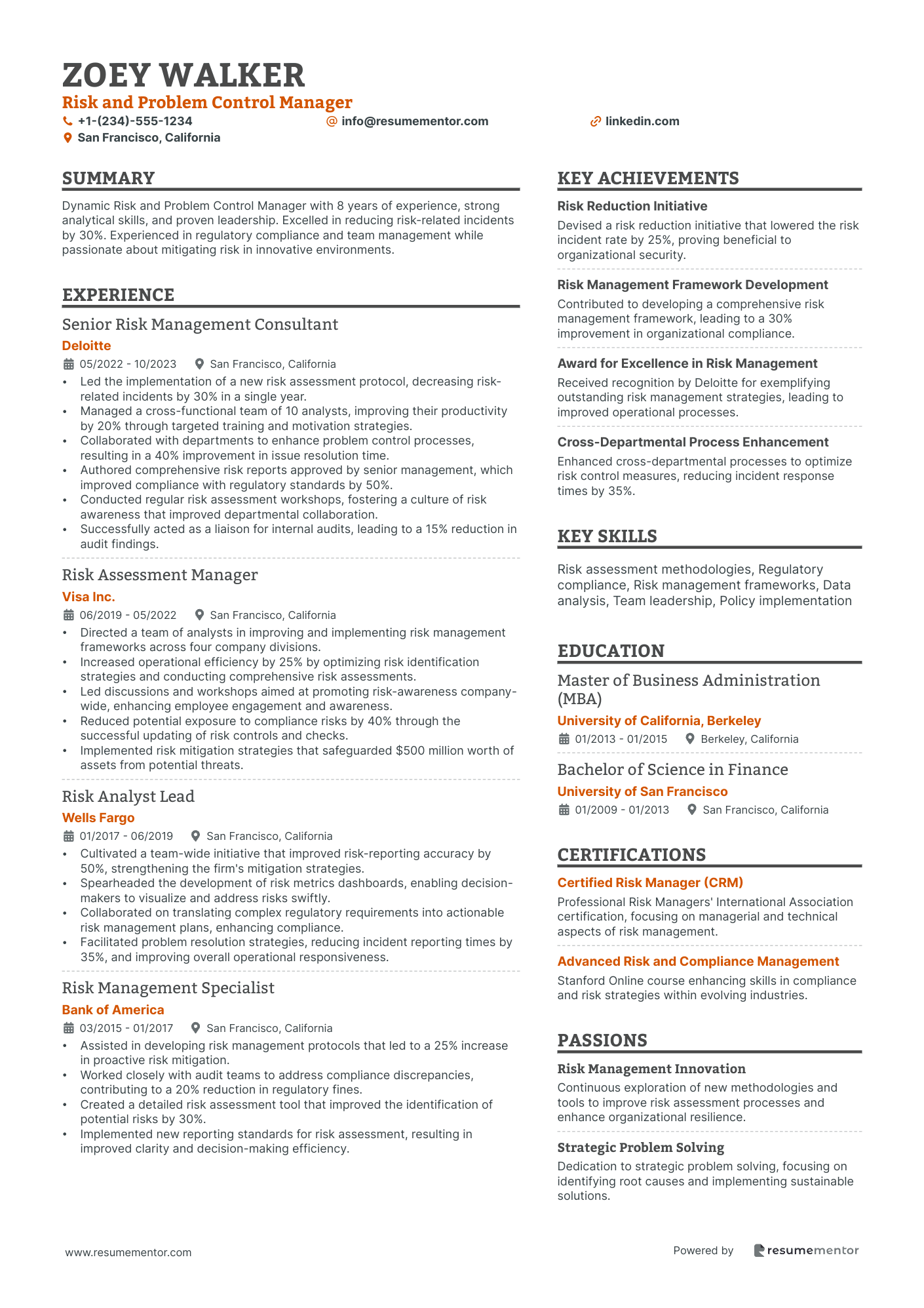
Risk and Problem Control Manager

IT Incident and Problem Manager resume sample
- •Managed the incident management process ensuring all incidents were resolved within SLA, improving compliance by 20%.
- •Led major incident response efforts, decreasing issue resolution time by 30% which reduced business impact.
- •Facilitated root cause analysis sessions that identified critical system vulnerabilities, resulting in 40% fewer issues.
- •Worked collaboratively with cross-functional teams to improve incident notification systems, enhancing communication efficiency by 25%.
- •Championed the update of problem management policies, achieving a 15% improvement in process consistency.
- •Conducted comprehensive post-incident reviews yielding strategic improvements, streamlining future incident management processes.
- •Drove the transformation of IT service processes, achieving a 50% reduction in time to resolve incidents.
- •Developed extensive training programs for team members, raising team efficiency by 35%.
- •Enhanced problem management strategies, reducing recurrent incidents by 25% through effective root cause analysis.
- •Reported service performance metrics to stakeholders, improving transparency by 20%.
- •Coordinated incident responses between global teams, ensuring zero critical incidents impacted service delivery.
- •Implemented new ITSM software tools, improving tracking efficiency by 40%.
- •Standardized system update protocols, reducing downtime during updates by 30%.
- •Spearheaded team workshops, cultivating a shared knowledge culture that led to 20% improved service metrics.
- •Conducted detailed PIRs, leading to enhancements in operational processes which decreased recurring incidents.
- •Analyzed IT service data to identify trends, optimizing incident response strategies by 25%.
- •Automated routine reporting tasks saving 15 hours weekly for the team.
- •Improved cross-departmental communication by developing better reporting templates, enhancing stakeholder engagement.
- •Supported ITSM tool enhancement projects, achieving a 20% increase in tool effectiveness for incident tracking.
Software Problem Resolution Manager resume sample
- •Led a team to reduce software issue resolution time by 30% through improved processes and cross-departmental collaboration.
- •Implemented root cause analysis measures, resulting in a 40% decrease in recurring software defects.
- •Conducted weekly updates for management that enhanced transparency and introduced 5 new metrics for tracking resolution success.
- •Developed a comprehensive triage process which improved initial response to customer issues by 25%.
- •Mentored junior team members in innovative problem-solving methods, resulting in a marked improvement in team performance scores by 15%.
- •Introduced an automated triage system that increased team productivity by 20%, enhancing the capability to handle a larger volume of issues.
- •Managed quality assurance teams in automating test scripts, leading to a 35% increase in testing efficiency and faster releases.
- •Collaborated with cross-functional teams to implement a new bug-tracking system, streamlining issue identification and resolution.
- •Increased customer satisfaction scores by 20% through improvements in defect management and enhanced support response times.
- •Led initiatives to integrate Agile methodologies within the QA team, which improved project delivery timelines by 25%.
- •Acted as a key point of contact for escalating and prioritizing severe issues, reducing resolution times for critical defects by 30%.
- •Supervised a technical support team to improve customer support satisfaction by 30% through targeted training and resources.
- •Resolved 85% of escalated issues within SLA timeframes, greatly enhancing customer retention and trust.
- •Introduced a new ticket prioritization system which led to an 18% decrease in average resolution times.
- •Coordinated with development teams to ensure client-reported issues were systematically addressed, improving support productivity by 20%.
- •Participated in developing new software features that improved user engagement metrics by 25%.
- •Performed code reviews which enhanced software reliability, decreasing post-launch defects by 15%.
- •Collaborated in a team environment to design and deploy a new payment gateway, supporting increased transaction volumes by 40%.
- •Contributed to a successful cloud migration project, facilitating a 30% reduction in infrastructure costs.
Digital Problem Management Specialist resume sample
- •Led a cross-functional team to resolve digital service issues, achieving a 20% reduction in problem incidents in one year.
- •Streamlined problem identification processes using data-driven techniques, leading to an increase in issue resolution speed by 35%.
- •Collaborated with IT teams to implement change management solutions, maintaining service availability during transitions.
- •Conducted root cause analysis, using 5 Whys and Fishbone diagrams, improving problem documentation and prevention strategies.
- •Regularly presented trend analysis reports to executive management, fostering a culture of continuous improvement.
- •Acted as a key liaison, enhancing stakeholder communication which resulted in a 25% increase in satisfaction ratings.
- •Analyzed and prioritized digital incidents based on user feedback, improving user experience for over 10,000 users.
- •Developed innovative workarounds for complex digital issues, resulting in a 40% decrease in user wait time.
- •Facilitated effective communication strategies between technical teams and stakeholders, optimizing information flow.
- •Implemented robust documentation practices, ensuring seamless access to knowledge base articles for future consolidations.
- •Monitored and reported on digital service metrics, providing insights for strategic improvements throughout operations.
- •Provided consultancy on ITIL best practices, aiding companies in enhancing their IT service management frameworks.
- •Guided teams in implementing ServiceNow, resulting in improved efficiency and lower incident response times by 50%.
- •Managed cross-department communication during high-impact changes, smoothing transition for all stakeholders involved.
- •Trained staff in advanced problem management techniques, empowering a team of 15 to resolve issues independently.
- •Streamlined internal processes, increasing problem detection and reduction by 15% through enhanced workflows.
- •Coordinated with developers to address underlying software issues, resulting in a 50% improvement in application stability.
- •Established a documentation protocol for problem history, resulting in significant time savings during issue analysis.
- •Facilitated retrospective sessions that contributed to process improvements and better service outcomes.
Enterprise Problem Manager resume sample
- •Led a team of problem managers, reducing problem resolution time by 25% through improved prioritization techniques.
- •Implemented a root cause analysis technique that improved accuracy of diagnoses by 40%, resulting in better issue resolution outcomes.
- •Enhanced reporting processes, which led to a 30% increase in actionable insights provided to senior management.
- •Facilitated cross-departmental review meetings, ensuring engagement from all stakeholders and improving solution implementation.
- •Developed training programs on problem management, increasing team efficiency and knowledge by 35% over 12 months.
- •Optimized the problem management toolset, leading to a more user-friendly experience and reducing data entry errors by 20%.
- •Devised strategies that reduced incident recurrence by 15% through effective problem resolution and documentation.
- •Collaborated with cross-functional teams resulting in the successful rollout of new incident management protocol.
- •Maintained and streamlined a problem database, improving data retrieval time by 25% for critical incidents.
- •Conducted regular training and mentorship sessions, resulting in increased proficiency in problem management across the team.
- •Generated comprehensive reports on root cause analysis, enhancing executive team insights and decision-making.
- •Managed high-priority incident investigations, improving resolution timelines by 20% through faster root cause identification.
- •Implemented an improvement plan leading to a 10% increase in customer satisfaction regarding service continuity.
- •Fostered communication between teams to streamline problem resolution, enhancing overall service quality by 15%.
- •Assessed problem management tools to align with industry trends, ensuring up-to-date practices across the department.
- •Coordinated incident reviews to address recurring issues, reducing the frequency by 12% through effective insights.
- •Enhanced problem categorization process, resulting in a 15% increase in accurate issue prioritization.
- •Instrumental in the adoption of new technologies within the team, boosting operational capacity by 10%.
- •Streamlined communication channels with incident management, leading to a 20% improvement in incident-handling efficiency.
Customer Issue Resolution Manager resume sample
- •Led a team of 20 representatives to enhance service efficiency, which resulted in a 30% reduction in complaint resolution time.
- •Implemented new customer inquiry processes, driving a 22% increase in first contact resolution rates.
- •Developed training programs that improved representative skills, leading to a 15% boost in customer satisfaction scores.
- •Collaborated with the IT department to integrate a new CRM system, improving team productivity by 18%.
- •Analyzed service trends, leading to the identification of process improvement areas, which improved service offerings by 12%.
- •Established performance monitoring KPIs, enhancing issue resolution effectiveness and decreasing repeat complaints by 25%.
- •Supervised a team in addressing customer complaints promptly, achieving a 20% improvement in resolution times.
- •Collaborated across departments to resolve escalated issues, improving cross-functional issue resolution efficiency by 30%.
- •Assisted in the development of a customer feedback program, increasing actionable insights by 40% per quarter.
- •Conducted workshops to enhance communication skills, resulting in a 15% reduction in customer escalations.
- •Generated monthly reports on customer issue trends that guided strategic initiatives, leading to a 10% increase in service quality.
- •Oversaw daily operations of a 15-member support team, ensuring efficient handling of 200+ daily inquiries.
- •Redesigned the customer complaint workflow to optimize performance, resulting in a 25% drop in processing time.
- •Monitored KPIs to evaluate team efficiency, enabling a 12% increase in customer retention through targeted interventions.
- •Developed and executed strategic communication plans to enhance client engagement, boosting satisfaction scores by 18%.
- •Resolved customer inquiries and technical issues, achieving a first-contact resolution rate of over 85%.
- •Identified and documented systemic issues, aiding the development team in reducing repeat service disruptions by 10%.
- •Contributed to process refinement initiatives, decreasing average response time by 20%, leading to higher customer satisfaction.
- •Engaged with over 500 customers monthly, enhancing service relationships and strengthening customer loyalty.
Operations Problem Management Coordinator resume sample
- •Led root cause analysis sessions for operational issues, reducing issue recurrence rates by 30% within the first year.
- •Developed a problem management framework that improved response times by 25%, enhancing service delivery across departments.
- •Facilitated cross-functional meetings to expedite problem resolution, resulting in a 15% reduction in downtime.
- •Designed and implemented a continuous improvement program that realized annual savings of $250,000.
- •Partnered with IT and operations teams to enhance problem escalation protocols, increasing resolution efficiency by 35%.
- •Trained over 120 staff members on problem management processes, boosting team capabilities in handling complex issues.
- •Managed daily operations, leading to a 20% increase in departmental output through streamlined processes.
- •Conducted comprehensive data analysis to identify performance trends, achieving a 15% reduction in operational bottlenecks.
- •Implemented an operations metrics dashboard, improving visibility and decision making by providing real-time data.
- •Played a key role in project planning and risk analysis, successfully mitigating potential operational disruptions.
- •Coordinated with logistics and distribution teams, enhancing supply chain efficiency by 10% and reducing overhead costs.
- •Conducted root cause analyses, leading to the resolution of critical operational issues in under 24 hours.
- •Developed a training module on process improvement techniques, boosting team productivity by 15% through enhanced skills.
- •Collaborated with senior management to deploy strategic initiatives, increasing operational efficiency organization-wide.
- •Utilized Lean methodologies to streamline workflows, achieving a 10% reduction in process lead times.
- •Facilitated process reviews, identifying and resolving inefficiencies that led to a 12% improvement in process accuracy.
- •Redesigned standard operating procedures, enhancing compliance and reducing error rates by 8%.
- •Contributed to team-wide continuous improvement initiatives, saving the department $150,000 annually through implemented changes.
- •Provided detailed reports on process performance, supporting data-driven management decisions to enhance operations.
Technical Problem Escalation Manager resume sample
- •Led cross-functional teams of up to 25 members to resolve critical technical issues, enhancing customer retention by 15%.
- •Developed streamlined escalation processes that reduced resolution time by 30%, improving overall team efficiency.
- •Guided engineering and product management teams in addressing complex challenges, resulting in a 20% increase in customer satisfaction.
- •Monitored and analyzed technical issue trends, providing product teams with actionable insights for improvement, leading to a reduction in repeat issues by 25%.
- •Implemented regular feedback collection from customers post-resolution, leading to targeted improvements in support services and achieving a KPI score of 95%.
- •Prepared detailed reports on escalated issues for senior management, leading to strategic process improvements across departments.
- •Managed a technical support team handling high-priority escalations, achieving a 98% resolution success rate.
- •Collaborated with engineering to create troubleshooting guides, reducing time-to-resolution for common issues by 40%.
- •Served as primary contact for key clients, handling technical conversations and ensuring satisfaction by resolving issues quickly.
- •Led initiatives to implement new ticketing systems, improving team workflow and decreasing communication delays by 20%.
- •Provided feedback to product management based on analysis of customer issues, resulting in key updates that reduced service tickets by 18%.
- •Resolved over 150 complex technical support cases monthly, maintaining a satisfaction rating of 95% across end users.
- •Trained new team members, sharing best practices and strategies for problem resolution, contributing to a reduction in training time by 25%.
- •Enhanced customer interaction protocols, improving overall service delivery and reducing escalation requirements by 15%.
- •Worked closely with cross-functional teams to deliver timely solutions, driving a 10% increase in client retention rates.
- •Maintained timely communication with customers, ensuring 99% of issues were followed up within 24 hours.
- •Collaborated with product teams to enhance software features, deriving improvements that led to a 12% decrease in reported bugs.
- •Executed numerous software updates and documented changes, resulting in a seamless customer experience during roll-outs.
- •Assisted in improving ticketing system configurations, resulting in a 20% reduction in misrouted tickets.
Business Process Problem Manager resume sample
- •Led cross-functional teams in process optimization projects, achieving a 30% improvement in workflow efficiency within one year.
- •Executed root cause analysis on recurring process issues, resulting in a 25% reduction in service downtime.
- •Developed comprehensive process maps for six critical operations, enhancing team productivity by 15%.
- •Facilitated 20+ stakeholder meetings, communicating actionable insights that led to a 10% increase in customer satisfaction.
- •Monitored and evaluated corrective actions, making data-driven adjustments to improve service delivery efficiency by 20%.
- •Collaborated with IT to implement technological solutions, reducing system errors by 18% and supporting ongoing process enhancements.
- •Spearheaded a project that standardized workflow processes, resulting in a 40% increase in overall department productivity.
- •Performed detailed analysis and resolved process bottlenecks, decreasing project completion times by 20%.
- •Designed and implemented new process documentation, enhancing compliance and reducing procedural errors by 30%.
- •Coordinated workshops with cross-sectional teams to identify improvement areas, facilitating 8% annual cost savings.
- •Partnered with engineering teams to deploy software solutions, streamlining operations and reducing manual interventions by 12%.
- •Analyzed business process workflows, identifying key inefficiencies and recommending changes that enhanced efficiency by 15%.
- •Led a task force to resolve cross-departmental issues, improving collaboration and reducing response times by 25%.
- •Developed key performance indicators for tracking process efficiency, leading to a 10% improvement in team response rates.
- •Participated in Six Sigma training sessions, applying learned techniques to achieve a 20% reduction in process variability.
- •Coordinated daily operations, improving logistics and reducing lead times by 15% through enhanced scheduling.
- •Implemented best practices for data collection, leading to more accurate reporting and a 5% increase in data reliability.
- •Managed a team of 10, fostering a collaborative environment that improved team productivity by 10%.
- •Streamlined communication processes with stakeholders, contributing to a 12% improvement in project milestone adherence.
System Failure Problem Manager resume sample
- •Implemented a streamlined problem management process, which reduced system failure resolution time by 25% and enhanced customer satisfaction.
- •Led cross-functional teams in root cause analysis sessions to identify underlying system issues, resulting in a 20% decrease in recurring incidents.
- •Developed comprehensive problem management metrics, facilitating data-driven decisions that optimized system performance.
- •Served as the main point of contact for internal stakeholders during system failures, ensuring clear communication and timely updates throughout the resolution process.
- •Facilitated training sessions on problem management best practices, raising team efficiency and awareness dramatically by 40%.
- •Prepared detailed reports for senior management on system performance trends, promoting proactive identification of potential issues.
- •Optimized problem management processes which improved system reliability by 15%, reducing customer-reported errors significantly.
- •Coordinated with incident and change management teams to manage complex projects ensuring seamless system operations and minimal user impact.
- •Established a robust problem management database, ensuring data accuracy and compliance with documentation standards, supporting better decision making.
- •Conducted thorough reviews of unresolved issues, ensuring escalation where necessary, thus ensuring 100% adherence to resolution timelines.
- •Engaged in continuous learning of industry best practices, leading to the implementation of innovative solutions and improved service quality.
- •Implemented ITIL framework practices within the company, improving overall system uptime by 22% over the course of three years.
- •Managed the lifecycle of problem incidents from initial identification through resolution and closure, achieving a 95% resolution rate.
- •Collaborated with technical teams to develop proactive solutions, anticipating potential failures and reducing incident frequency.
- •Delivered detailed problem reports to stakeholders, fostering transparency and confidence in issue resolution processes.
- •Reduced system downtime by 18% through targeted improvements in problem management protocols and timely issue resolutions.
- •Led a team in conducting root cause analysis for complex system failures, ensuring corrective measures were documented and implemented effectively.
- •Improved client satisfaction scores by 20% by optimizing communication channels and ensuring transparency in problem resolution efforts.
- •Created and maintained comprehensive documentation for all problem incidents, reinforcing the organization’s knowledge management initiatives.
Risk and Problem Control Manager resume sample
- •Led the implementation of a new risk assessment protocol, decreasing risk-related incidents by 30% in a single year.
- •Managed a cross-functional team of 10 analysts, improving their productivity by 20% through targeted training and motivation strategies.
- •Collaborated with departments to enhance problem control processes, resulting in a 40% improvement in issue resolution time.
- •Authored comprehensive risk reports approved by senior management, which improved compliance with regulatory standards by 50%.
- •Conducted regular risk assessment workshops, fostering a culture of risk awareness that improved departmental collaboration.
- •Successfully acted as a liaison for internal audits, leading to a 15% reduction in audit findings.
- •Directed a team of analysts in improving and implementing risk management frameworks across four company divisions.
- •Increased operational efficiency by 25% by optimizing risk identification strategies and conducting comprehensive risk assessments.
- •Led discussions and workshops aimed at promoting risk-awareness company-wide, enhancing employee engagement and awareness.
- •Reduced potential exposure to compliance risks by 40% through the successful updating of risk controls and checks.
- •Implemented risk mitigation strategies that safeguarded $500 million worth of assets from potential threats.
- •Cultivated a team-wide initiative that improved risk-reporting accuracy by 50%, strengthening the firm's mitigation strategies.
- •Spearheaded the development of risk metrics dashboards, enabling decision-makers to visualize and address risks swiftly.
- •Collaborated on translating complex regulatory requirements into actionable risk management plans, enhancing compliance.
- •Facilitated problem resolution strategies, reducing incident reporting times by 35%, and improving overall operational responsiveness.
- •Assisted in developing risk management protocols that led to a 25% increase in proactive risk mitigation.
- •Worked closely with audit teams to address compliance discrepancies, contributing to a 20% reduction in regulatory fines.
- •Created a detailed risk assessment tool that improved the identification of potential risks by 30%.
- •Implemented new reporting standards for risk assessment, resulting in improved clarity and decision-making efficiency.
In the complex world of problem management, your ability to analyze issues and craft solutions is crucial. Yet, when it's time to seek new opportunities, translating those skills into a compelling resume can feel like navigating a maze. As a problem manager, you face the unique challenge of showcasing your strategic acumen within a limited space. Highlighting your abilities to prevent issues, minimize impact, and implement efficient solutions becomes essential.
Condensing vast experience into a single page is no small feat. However, a well-structured resume template can make this task much simpler by ensuring your document is both polished and organized. With a professional resume template, you can direct your efforts towards crafting strong content instead of worrying about formatting details.
Communicate your mastery of problem-solving through clear examples that demonstrate your ability to drive change. Highlight key achievements and metrics that reflect your impact on past organizations. Rather than just listing duties, ensure each section emphasizes how you contributed to overall success.
What might seem a daunting task becomes manageable with the right tools. A reliable template helps you map out your career trajectory smoothly. This way, you can confidently showcase your skills and achievements, making the impression you need to advance as a problem manager. Dive into this guide to craft a resume that truly reflects your dedication and expertise.
Key Takeaways
- A problem manager resume should effectively communicate your proficiency in tackling complex IT challenges, leadership in problem-solving initiatives, and dedication to minimizing business disruptions.
- Organize your resume with clear sections including contact information, professional summary, experience, skills, education, and achievements, ensuring each area emphasizes your contributions to overall success.
- Quantify your achievements using metrics to demonstrate your capabilities and impact, such as reducing incident resolution times or improving efficiency, and use action verbs to create a dynamic narrative.
- Choose a professional resume format and use modern fonts to ensure clarity and professionalism, ensuring your resume is easy to read and looks polished across different devices.
- Include both hard and soft skills relevant to problem management, such as ITIL knowledge, change management, communication, and leadership, to optimize your chances for selection by applicant tracking systems.
What to focus on when writing your problem manager resume
A problem manager resume should effectively communicate your proficiency in tackling complex IT challenges with ease. It needs to show your leadership in problem-solving initiatives, along with your strong analytical and communication skills, underscoring your dedication to minimizing business disruptions. Highlight the processes you've improved and your teamwork with cross-functional groups to achieve success.
How to structure your problem manager resume
- Contact Information — Provide your full name, phone number, professional email, and LinkedIn profile. Using a professional email address adds credibility and ensures recruiters can easily reach you. Ensure this information is clear and positioned at the top for immediate access by hiring managers who often look for it first.
- Professional Summary — This section should briefly encapsulate your journey in problem management, mentioning your expertise in incident resolution and ITIL practices, along with your track record of reducing operational downtime. Crafting this summary as a concise, impactful narrative gives potential employers a snapshot of your professional persona, making them want to learn more as they delve into your resume.
- Experience — When detailing your previous roles, focus on sharing achievements that illustrate your ability to improve efficiency, such as reducing incident response times or spearheading effective root cause analyses. Use quantifiable metrics where possible to demonstrate the value you've brought to your past positions, painting a vivid picture of your capabilities to your next potential employer.
- Skills — Build on your experience by listing technical skills pertinent to problem management, like ITIL certification, change management, and service delivery expertise. Complement these with vital soft skills such as communication and leadership. Tailor these skills to match the job description, ensuring relevance and optimizing your chances for selection by applicant tracking systems.
- Education — Alongside your degrees, make sure to highlight any relevant certifications, specifically ITIL training, as these underpin your capabilities and dedication to the field. Providing this background showcases your foundational knowledge and continuous professional development, positioning you as a highly qualified candidate.
- Achievements — Use this area to emphasize key milestones in your career, such as implementing process improvements that boost efficiency or significantly cutting down problem recurrence rates. Demonstrating these achievements offers concrete examples of your professional impact and ability to drive results.
By connecting each section thoughtfully, you create a cohesive narrative that paints a comprehensive picture of your qualifications. As we delve into each section below, we'll explore more in-depth strategies to enhance your problem manager resume's effectiveness.
Which resume format to choose
Choosing the right resume format is important for a problem manager, as it effectively showcases your skills and experience. A chronological format serves you well if you have a history of steady employment. This approach highlights your growth and achievements over time, demonstrating how you've advanced in your roles and tackled complex issues successfully.
The font you choose can subtly impact how your resume is perceived. Opt for modern fonts like Rubik, Lato, or Montserrat to give your resume a clean and up-to-date look. These fonts are professional and easy to read, ensuring that hiring managers focus on your accomplishments.
It's crucial to save your resume as a PDF. This file type maintains your carefully chosen formatting on any device or operating system, ensuring that your resume looks polished and professional no matter who opens it.
Consider your margins as part of the overall readability. Using one-inch margins creates a clean, balanced layout with enough white space to make the text easy on the eyes. This balance ensures your resume remains inviting and not overwhelming, keeping the focus on your most important qualities and skills as a problem manager. These elements—format, font, file type, and margins—combine to create a compelling and professional resume.
How to write a quantifiable resume experience section
The experience section is the heart of your problem manager resume because it aligns your past roles with the position you’re aiming for. Highlight achievements and results to demonstrate your fit. Begin with your most recent experience, covering up to 10-15 years of relevant roles. Tailor the content to the job ad by incorporating relevant keywords and phrases that reflect what employers are seeking. Use action words like “achieved,” “resolved,” and “enhanced” to convey impact, and prioritize quantifiable achievements that clearly illustrate your value.
- •Reduced incident resolution time by 30% through improved processes.
- •Achieved a 95% problem resolution rate, boosting customer satisfaction.
- •Implemented a root cause analysis framework, cutting recurring issues by 40%.
- •Worked across teams to increase efficiency by 20%.
This experience section is compelling because it ties your success directly to measurable achievements, using data to underline your expertise. The action verbs in each bullet point create a dynamic narrative, drawing the reader into your proactive approach. Tailoring each entry to the job ad demonstrates how your skills meet the employer's needs, providing a strong match. By including specific numbers, you effectively convey the scale and significance of your achievements, making your contributions tangible and impressive to potential employers.
Result-Focused resume experience section
A result-focused problem manager resume experience section should clearly highlight your ability to identify and resolve issues, improving the efficiency and reliability of operations. Start by focusing on your achievements, showcasing the positive outcomes you’ve achieved rather than just listing responsibilities. Use specific numbers and percentages to support your results and strong action verbs to convey your proactive approach. Your bullet points should illustrate how you’ve enhanced processes, reduced downtime, or increased efficiency, tying these improvements to your problem-solving skills.
Emphasize your leadership and ability to work with teams by highlighting the initiatives you’ve led and the innovative solutions you've implemented. Tailor each entry to showcase your troubleshooting expertise and the tools or methodologies you've used. This creates a clear narrative demonstrating your ability to contribute to organizational success by swiftly and effectively tackling complex problems.
Senior Problem Manager
Tech Solutions Inc.
January 2020 - Present
- Reduced system downtime by 30% through proactive monitoring and swift issue resolution.
- Implemented a problem management process that cut incident resolution time by 40%, improving overall service reliability.
- Led cross-functional teams to uncover root causes, leading to a 20% boost in process efficiency and better team collaboration.
- Introduced a new problem-tracking system, elevating reporting accuracy by 50% and enhancing data-driven decision-making.
Industry-Specific Focus resume experience section
A problem manager-focused resume experience section should highlight the skills that are crucial in managing and resolving issues effectively. Begin by clearly outlining your responsibilities and achievements, concentrating on the tangible outcomes your efforts produced. This helps hiring managers see the real impact of your work, beyond just listing tasks, and understand how you contributed to the company or projects you worked on.
To create a smooth reading flow, use strong action words and quantifiable metrics to describe your accomplishments, like how you reduced incident times or improved efficiency. Avoid using complex jargon, and instead, clearly explain your role and the results you achieved. This approach makes it easy for readers to connect your experiences with their needs and see you as a valuable asset.
Problem Manager
Tech Solutions Corp
January 2021 - Present
- Cut incident resolution time by 35% with improved problem-solving methods, leading to faster recovery and happier clients.
- Led a team in redesigning workflows, which resulted in a 25% boost in operational efficiency and smoother daily operations.
- Implemented a new problem-tracking system, successfully decreasing repeat incidents by 40% and improving overall service quality.
- Facilitated monthly meetings with stakeholders to address recurring issues promptly, fostering better communication and proactive solutions.
Problem-Solving Focused resume experience section
A problem-solving focused problem manager resume experience section should clearly demonstrate your ability to identify and resolve issues effectively. Begin by listing your employment dates, job title, and company name in a clear and readable format. This initial part sets the foundation for highlighting your achievements. Use simple, straightforward language to ensure a smooth reading experience that effortlessly guides the reader through your professional journey.
In the bullet points, delve into specific instances where you led efforts to tackle significant problems and delivered remarkable results. Use dynamic, action-oriented language to seamlessly connect your initiative with the outcomes. This approach not only highlights your problem-solving prowess but also illustrates your leadership and capacity to foster positive change. Allow these accomplishments to weave a narrative of your expertise, painting a vivid picture of your contributions rather than merely listing your job responsibilities.
Problem Manager
Tech Solutions Inc.
June 2020 - Present
- Reduced system errors by 30% through revamping key processes.
- Led a cross-functional team to quickly identify root causes and apply solutions.
- Created a tracking system that improved issue resolution times by 40%.
- Trained team members on effective techniques for identifying and solving problems.
Responsibility-Focused resume experience section
A responsibility-focused problem manager resume experience section should emphasize your ability to predict, identify, and solve problems effectively. Start by showcasing the key responsibilities and achievements that underline your skills in navigating and resolving issues, using active language to convey how you've minimized risks, improved systems, and fostered team collaboration. This approach makes it easy for employers to understand your capability in handling and preventing potential problems.
Illustrate the impact of your actions by providing specific examples, linking your efforts directly to the positive outcomes achieved. Keep each bullet point clear and impactful, focusing on how these responsibilities have contributed to your workplace's success and how you've made tangible improvements in problem management situations. This will make your resume both engaging and informative for hiring managers.
Problem Manager
Tech Solutions Inc.
March 2019 - Present
- Reduced system downtime by 30% through proactive identification and resolution of recurring problems.
- Led cross-functional teams in root cause analysis, improving incident management processes.
- Implemented a new tracking system that decreased issue resolution time by 50%.
- Developed training programs to enhance team skills in recognizing and handling potential issues.
Write your problem manager resume summary section
A problem manager-focused resume experience section should clearly present your strengths and achievements to potential employers. It’s essential that a well-crafted summary quickly highlights your key skills and experiences. If you have years of experience as a problem manager, emphasize your capability to tackle complex issues and improve processes. You might write something like:
This example not only details your experience but also highlights the direct impact you’ve made, such as reducing downtime—a benefit any employer would appreciate. Describing yourself with confidence and including your main achievements ensures you effectively convey your readiness for new challenges.
Understanding how a resume summary differs from other sections, like a resume objective, profile, or summary of qualifications, is crucial. While a summary centers on your past accomplishments and skills, an objective is better suited for those with less experience, focusing on your career goals. A profile gives an overview of broader career traits, and a summary of qualifications succinctly lists essential skills. Choosing the right section depends on your career stage and experience level, helping you present your professional story effectively.
Listing your problem manager skills on your resume
A skills-focused problem manager resume should clearly highlight what makes you effective in this role. Whether you choose a standalone section or integrate these skills into your experience and summary, showcasing your strengths is key. Soft skills demonstrate how well you collaborate with others and lead teams, while hard skills highlight your technical abilities and expertise. Including both types of skills on your resume not only elevates your profile but also helps your resume pass automated screening tools.
Here's an example in JSON format:
This skills section effectively captures the essential abilities for a problem manager role. Highlighting skills like critical thinking and problem solving conveys your capability to tackle challenges efficiently. Mentioning IT service management and change management showcases your technical skills and adaptability. Skills like risk management and stakeholder management demonstrate strong planning and collaboration abilities—essential for a successful problem manager.
Best hard skills to feature on your problem manager resume
In a problem manager role, hard skills should emphasize your technical proficiency and managerial acumen. These skills signal your ability to solve complex problems and manage processes effectively.
Hard Skills
- Incident Management
- Root Cause Analysis
- ITIL Framework Knowledge
- Change Management
- Risk Assessment
- Data Analysis
- Service Level Management
- Process Improvement Methodologies
- Business Continuity Planning
- Vendor Management
- Technical Documentation
- Performance Metrics Analysis
- Budget Planning
- System Deployment
- Networking and Monitoring Tools
Best soft skills to feature on your problem manager resume
Equally important are the soft skills that highlight your leadership and communication strengths. These should communicate your ability to collaborate and maintain a productive work environment.
Soft Skills
- Empathy
- Leadership
- Communication
- Adaptability
- Time Management
- Team Coordination
- Negotiation
- Conflict Resolution
- Critical Thinking
- Decision Making
- Stress Management
- Active Listening
- Emotional Intelligence
- Persuasion
- Patience
How to include your education on your resume
The education section of your resume is an essential piece that highlights your academic background. It must be tailored to the job you're applying for; irrelevant education should be omitted to maintain focus on qualifications that matter. Including your GPA on a resume is optional, but if it's high (above 3.5), it can highlight academic excellence. If you graduated with honors, such as cum laude, it's worth including as it speaks to your academic dedication. When listing a degree, clearly state the level, major, and the institution from which it was earned.
Here is an example of an incorrect education section, which could negatively impact your application for a problem manager position:
In contrast, a well-crafted education section for a problem manager role reads like this:
This example effectively communicates relevant education, showcasing a degree in Information Technology, which aligns directly with a problem manager's technical expertise. Including cum laude honors highlights your academic dedication, and a high GPA further emphasizes your strong educational performance.
How to include problem manager certificates on your resume
Including a certificates section in your resume is essential if you're aiming for a problem manager role. List the name of the certificate to make it clear what qualifications you hold. Include the date of completion to show how recent and relevant your education is. Add the issuing organization to verify the credibility of your certification. Certificates can also be highlighted in the header. For example, after your name, you could write: "Jane Doe, ITIL Certified".
Here's how a good certificates section could look:
This example is effective because it includes certificates directly related to problem management, enhancing your relevancy. It clearly states the name, date, and issuing authority, establishing credibility. These concise and straightforward entries make it easy for hiring managers to see your qualifications at a glance.
Extra sections to include in your problem manager resume
In the competitive world of problem management, a well-crafted resume can distinguish you from the crowd. Tailoring your resume to highlight specific sections can provide a comprehensive view of your skills and experiences.
- Language section — Demonstrate your language proficiency by listing both native and learned languages. Highlighting this section can show your ability to communicate with diverse teams or clients effectively.
- Hobbies and interests section — Show your personality and creative side by listing relevant hobbies and interests. Including this section can make you more relatable and human to potential employers.
- Volunteer work section — Illustrate your commitment to community and teamwork by detailing your volunteer efforts. Employers value this section as it shows initiative, empathy, and skills gained outside of a traditional job setting.
- Books section — Highlight your continuous learning by mentioning books related to problem management, such as "The Phoenix Project" or "ITIL Foundation." This section can show your dedication to staying informed about industry best practices.
In Conclusion
In conclusion, crafting a standout resume as a problem manager requires a strategic and thoughtful approach. Your resume should effectively convey your problem-solving abilities, relevant experiences, and achievements. Focus on quantifiable results to clearly demonstrate how your efforts have positively impacted past organizations. It's important to use a professional template to ensure your resume is well-organized and visually appealing, allowing you to concentrate on the content rather than the format.
A chronological format is generally recommended for those with a steady work history, as it effectively showcases career progression and achievements. Carefully choose modern and readable fonts, and ensure your resume is saved as a PDF to maintain its formatting across different platforms. Attention to these details will enhance the overall professionalism of your document.
Your experience section should use actionable language and specific metrics to highlight your successes in past roles. By connecting your skills and achievements with the potential employer's needs, your resume will resonate with hiring managers. Including a mix of both hard and soft skills is essential, as it demonstrates a comprehensive skill set that covers technical expertise and interpersonal effectiveness.
Don't overlook the education and certification sections, as they bolster your credentials. Highlight relevant degrees, certifications like ITIL, and any honors or high GPAs. Consider adding extra sections that reflect your personal interests and additional qualifications, such as languages or volunteer work, to provide a holistic view of your professional and personal endeavors.
By following these guidelines, you will create a compelling narrative that not only showcases your qualifications but also positions you as a valuable asset in the competitive field of problem management. Each section of your resume should seamlessly interlink to paint a cohesive picture of a dedicated and skilled problem manager ready to tackle complex challenges.
Related Articles
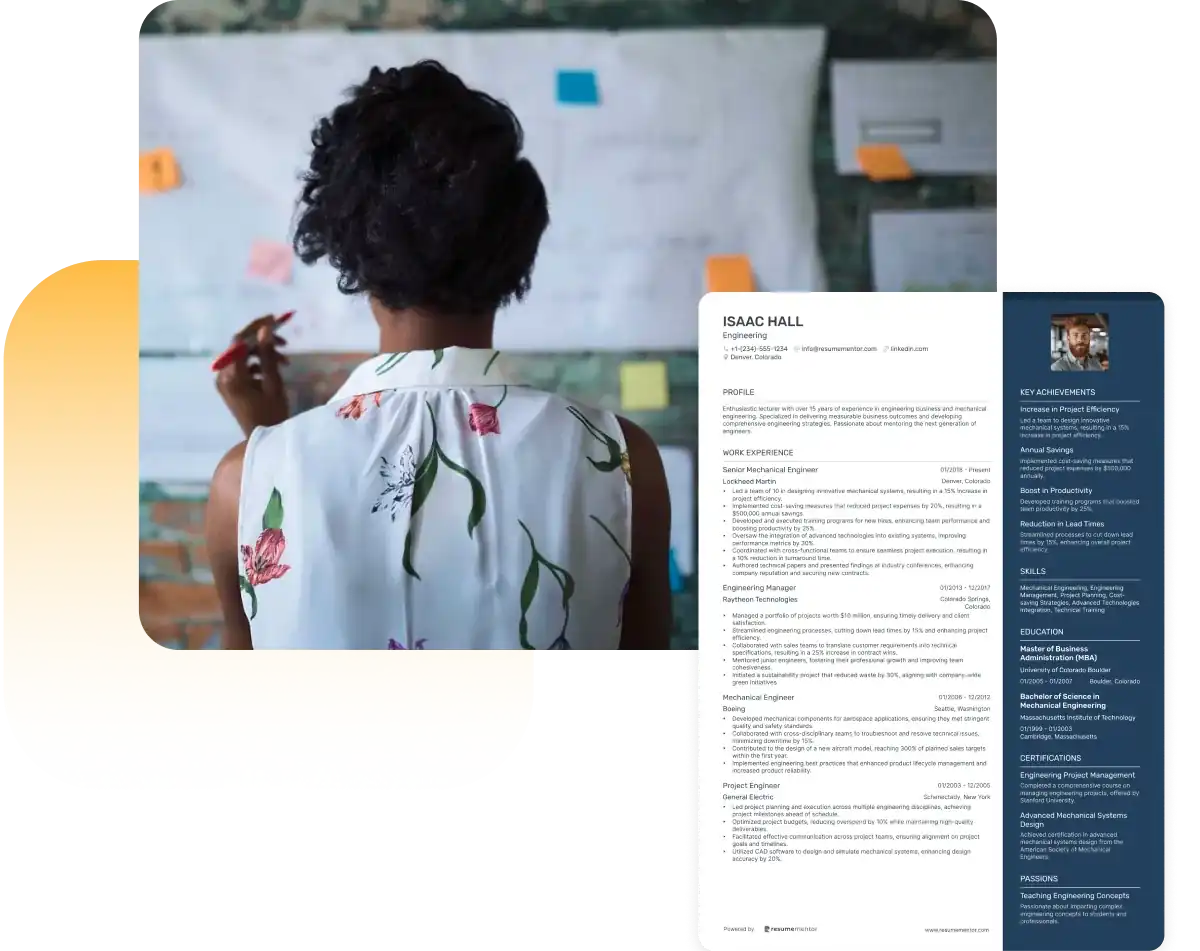
Continue Reading
Check more recommended readings to get the job of your dreams.
Resume
Resources
Tools
© 2025. All rights reserved.
Made with love by people who care.

